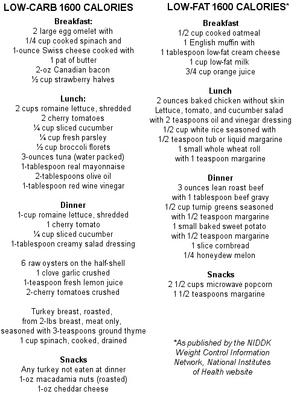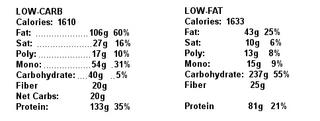In part 1 of my examination of low-carb and traditional dietary recommendations, I stated that the percentage of calories from fat, carbohydrate and protein is not a measure of diet quality. I contend that trying to plan a menu within the "conventional wisdom" of 30% or less calories from fat, 15% of calories from protein and 55% of calories from carbohydrate actually provides LESS nutritional quality than a very low-carb diet!
In today's article, I'll show you a side-by-side comparison of two menus - one is a very low-carb menu providing approximately 1600-calories, the second a traditional low-fat menu providing 30% or less calories from fat.
To reduce the potential for bias with the creation of a low-fat menu, I'm using a published 1600-calorie menu from the National Institutes of Health, from their website "WIN" (Weight-Control Information Network), part of the National Institute of Diabetes and Digestive Kidney Disease (NIDDK).
The very low-carb menu is one that I used myself when I was losing weight back in 2001. I created it by following the Rules of Induction and the List of Acceptable Foods for Atkins. This particular menu came from week 4, so it includes some fruit - specifically strawberries - while still remaining at 20g net carbohydrate or less for the day. This was one of the rare days that my calories dropped below 1800-calories and one of the rare days that even I was not able to finish all of the food I planned into the menu!
So, what is on the menus?

Now I bet you're wondering what each looks like for carbs, fats and protein. How about we take a look?

The low-carb menu followed just one rule - keep carbohydrate intake at or below 20g net carbohydrates (net = deducting only fiber). The published menu from the WIN website stayed within the guidelines to keep fat intake at or below 30%, protein was slightly higher than 15% at 21% but still acceptable and the carbohydrate content was 55% of calories and provided 25g of fiber.
So, from a "macronutrient" view, the low-carb menu is "unhealthy" and "unbalanced" and the low-fat menu is right on target, balanced and well within the recommendations for percentage of calories in a day, right? Just how did each menu do from a "nutrient" perspective? That is, how well did each do to provide essential nutrients?
Would you be surprised if I told you that the very low-carb menu met or exceeded RDA's for ALL vitamins and minerals? Don't be - it did. It met or exceeded every RDA for Vitamins A, D, E, K, C, B6, B12, Niacin, Thiamin, Riboflavin and Folate; it met or exceeded every RDA for Minerals Iron, Zinc, Copper, Calcium and Phosporus. And, while there is no RDA for Sodium and Potassium, the ratios for the two were good and intake was adequate based on the Institute of Medicine's Adequate Intake (AI) recommendations, with 2324mg of Sodium and 3565mg of Potassium.
So, how did the WIN menu, from the NIH/NIDDK fare nutritionally?
In a word - poor. It was deficient in a number of vitamins and minerals.
It was deficient in Vitamins D and E.
It was deficient in Minerals Zinc and Magnesium.
The sodium and potassium intake was similar to the low-carb menu - adequate intake, acceptable ratios.
I don't know about you, but when NIH/NIDDK menu, crafted by experts with access to powerful nutrition software, is deficient, is there any hope that the average person can get a menu that meets or exceeds their RDA for vitamins and minerals when the one published by an "authority" fails?
Do you really think it's a good idea to promote menus that are deficient in essential nutrients tot he general public? I didn't think so!
As my own menu showed, it is possible to meet and exceed nutrient requirements by choosing nutrient dense foods! Notice my menu contained no grains, no legumes, no pasta, no rice, no cereal and a limited amount of nuts and fruit. Yet, this very low-carb menu exceeded all RDA's.
Now, the "experts" are trying to tell you that a very low-carb menu is nutritionally deficient! How exactly is meeting requirements for vitamins and minerals deficient?
I hope you're starting to see that:
- Grains are not necessary to meet nutrient requirements
- Pasta, bread, cereal and rice is not necessary to meet nutrient requirements
- Sugary foods like cake, cookies and candy are not necessary to meet nutrient requirements
- Large quantities of fruit is not necessary to meet nutrient requirements
In fact - the key to eating well and meeting and exceeding nutrient requirements each day is to pay attention to the essential nutrients and NOT the macronutrients as a percentage of your daily calories!
Keep in mind too, that if you decide to try a low-carb diet, talk with your physician, have your bloodwork done and skip the processed foods touted as "low-carb" - you don't need them!
Keep in mind too, that with time you can and should re-introduce a full variety of carbohydrate foods that you like as you migrate toward the long-term "controlled-carb" approach for life!
Tomorrow, in Part 3, I'll provide insight into why nutrient-density is important by reviewing each macronutrient and its role in our diet, why low-carb diets can meet or exceed RDA's for essential nutrients and how the shift from a nutritionally deficient to a nutritionally rich diet improves your health!






No comments:
Post a Comment